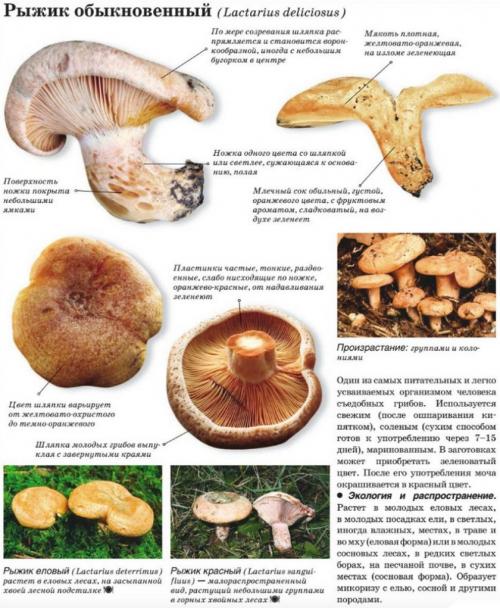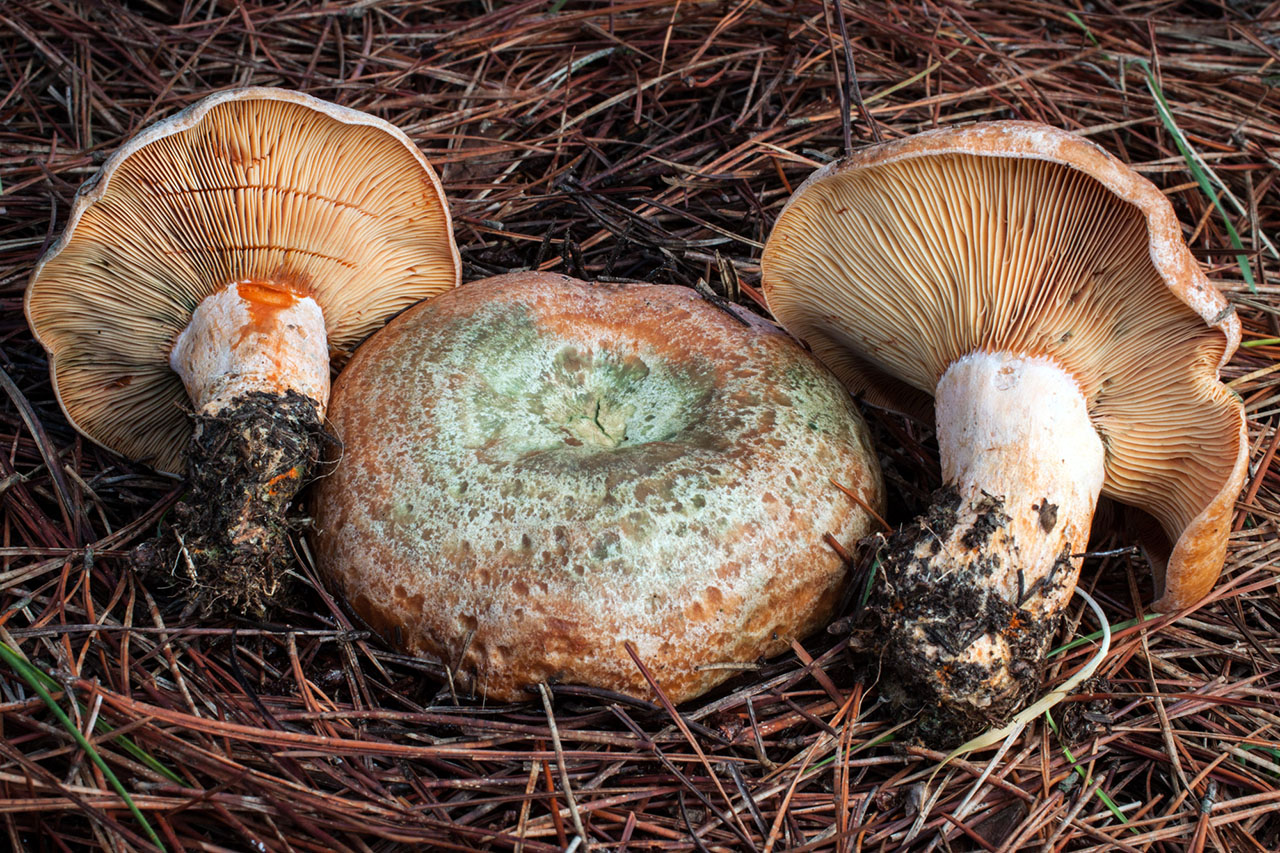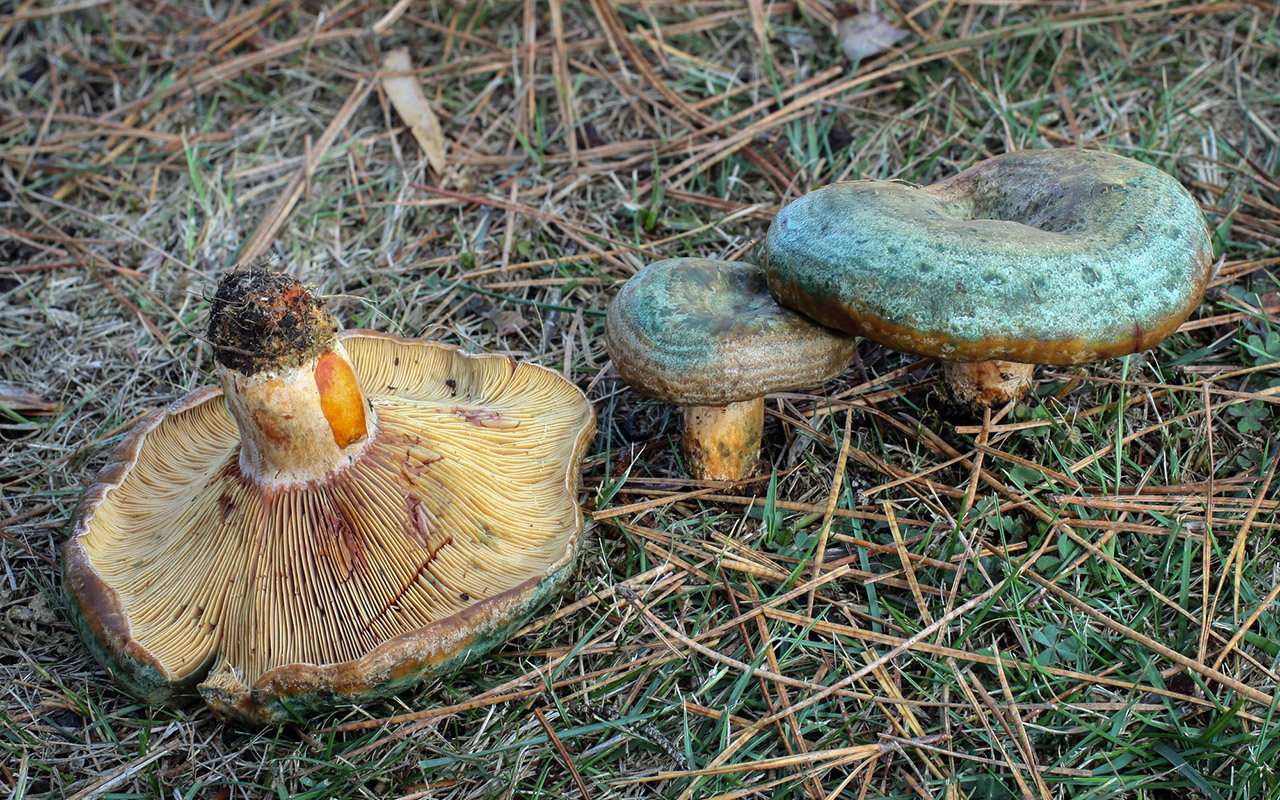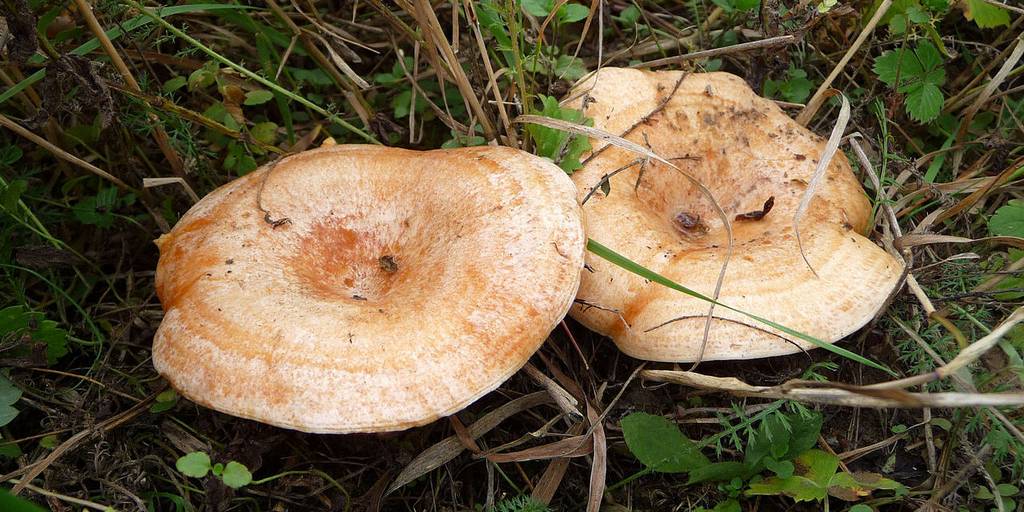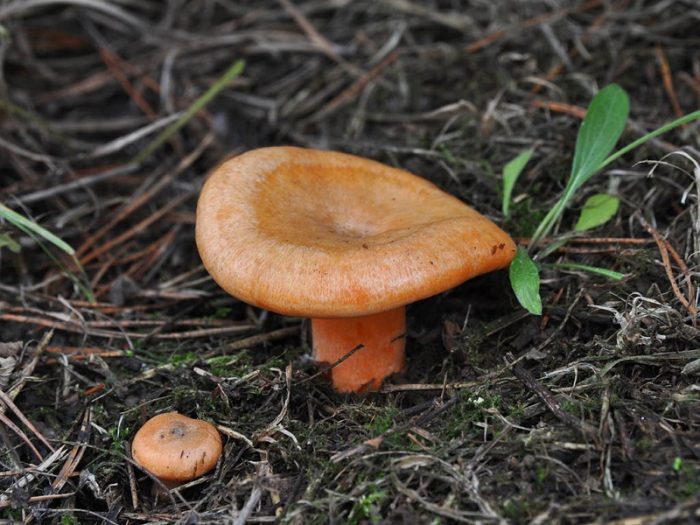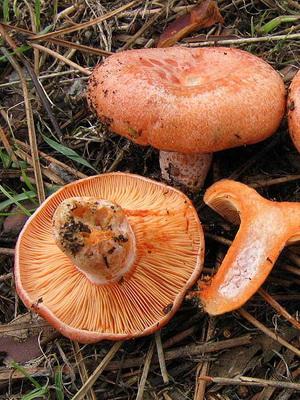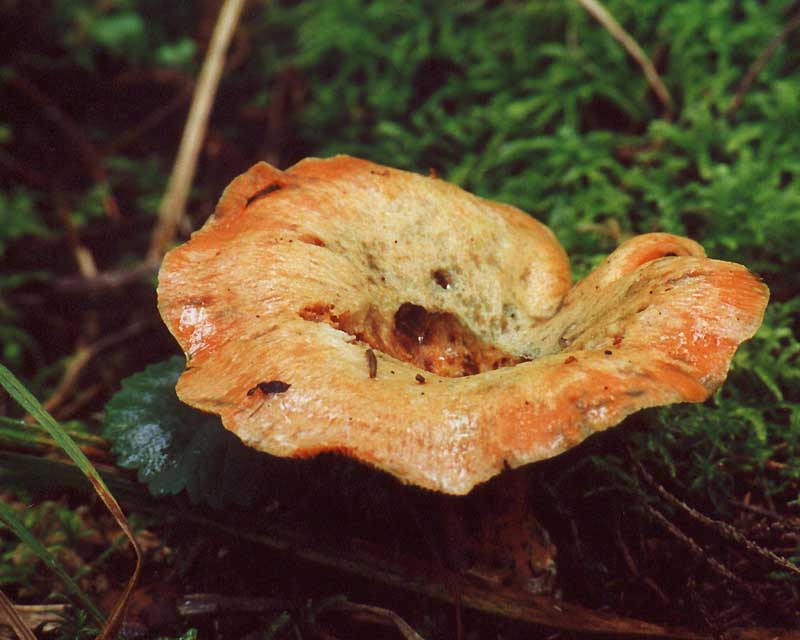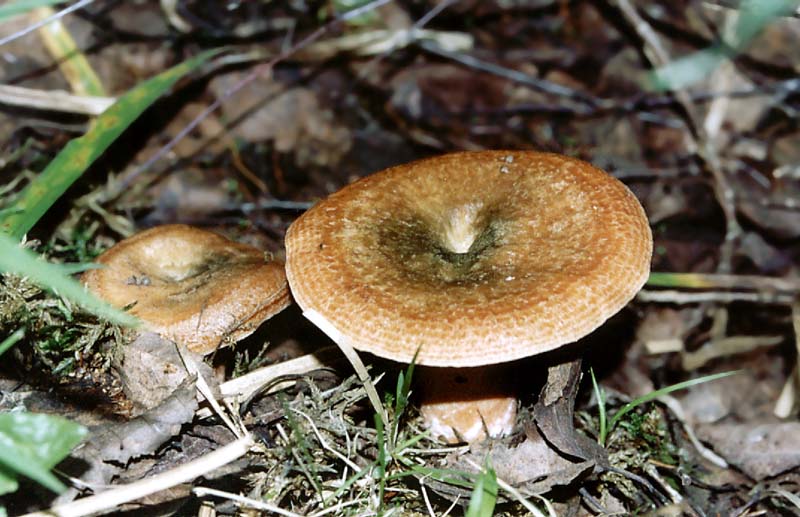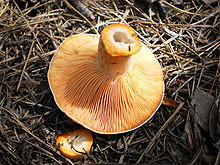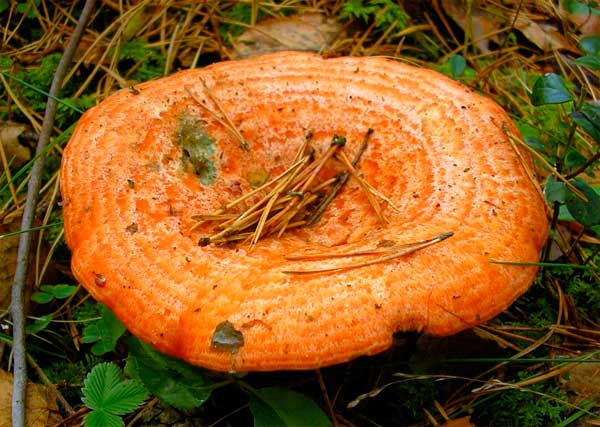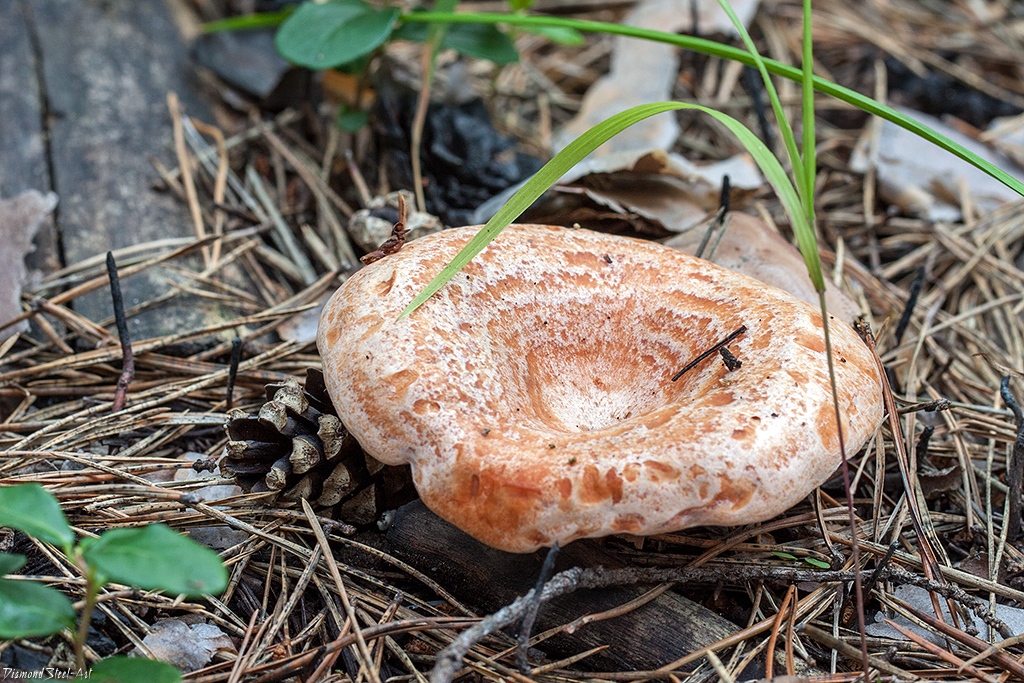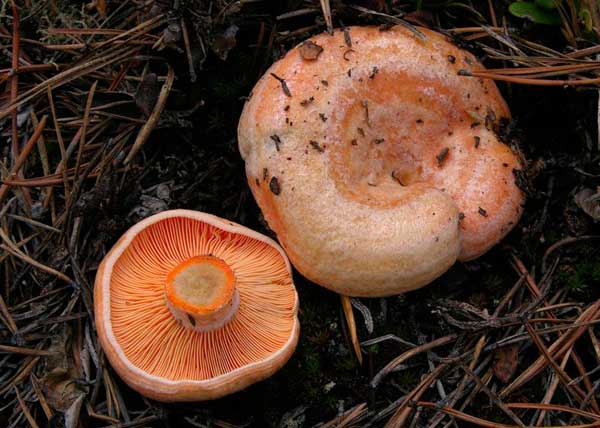Where and at what time does it grow
Fans of salted forest mushrooms are interested in where the mushrooms grow. They are ubiquitous, although they are most common in Europe and North America. Most of the species live in symbiosis with conifers, so you need to look for them under spruces, pines and Crimean firs. The only exception is oak mushroom, which is also called milk mushroom. It grows under deciduous trees.
Lighting is of great importance for the growth of fruit bodies. Ryzhiks do not tolerate shade and too dense forests, therefore they are more often found on forest edges, glades and glades. On sandy loam soil, they are often found in large groups, forming "witch circles".
The pulp of saffron milk caps is very tender and does not tolerate cold. Therefore, the harvest season falls in the summer months and autumn. The optimum temperature for the development of fruiting bodies is + 17-27 degrees. With the onset of frost, the reproduction of mushrooms stops.
Growing at home and in the country
The mushroom will not grow at home. However, if there is a large plot of land, you can try cultivating.
First of all, you need to choose the time of year - this is the beginning of summer, June. To create natural, natural conditions for saffron milk caps - plant Christmas trees and pines from 10 years old. Water it abundantly only with rain or melt water. Sow the ground with fungal spores. How to do it? There are several ways:
- Finely chop the caps of the fruit, dry slightly and place in prepared, moist soil. Cover with moss on top.
- Also grind the caps and pour warm, slightly sweet water, wait a day. Then sow this "dough" into the ground, as in the first method.
After a week, you need to check the progress of the engraftment process. If, having lifted the moss, in one of the sown areas, you find threads of green and purple color (mycelium) - this will be a sign that the mushrooms have begun. And then in a year wait for their first harvest.
Be careful when assembling. Trim the stem carefully so as not to damage the root, otherwise the next year the fruits may not appear
Photo and description of pine mushroom:
Pine mushroom (Lactarius deliciosus (L.: Fr.) S. F. Gray)
 In saffron milk caps, the cap is 5–15 cm in diameter, at first hemispherical, velvety, then convex with a curled edge, convex-outstretched, slightly depressed, with a lowered thin edge, later funnel-shaped with a straight thin edge, reddish-orange, brick-red to gray-red or greyish-olive, with darker distinct annular zones, sticky in wet weather.
In saffron milk caps, the cap is 5–15 cm in diameter, at first hemispherical, velvety, then convex with a curled edge, convex-outstretched, slightly depressed, with a lowered thin edge, later funnel-shaped with a straight thin edge, reddish-orange, brick-red to gray-red or greyish-olive, with darker distinct annular zones, sticky in wet weather.
The plates are frequent, orange to orange-yellow, slowly turn green when pressed. The pulp is yellow-orange, quickly turns red on the cut, then turns green, with a pleasant taste.
Milky juice is orange- or carrot-red, does not change color in air or gradually becomes grayish-green. Stem 3–7 × 1–2 cm, cylindrical, often with orange depressed spots, turns green when touched.
Distributed throughout the temperate zone of Russia, forms mycorrhiza with pine. It grows on sandy soils in pine forests, on pine edges, in forests with pine, in pine plantations and windbreaks of forest belts, in grass, among mosses.
Fruiting from July to early November.
Skillfully pickled mushrooms have long been considered an exquisite dish not only in Russia, but also abroad. In the Urals, during a large harvest, these mushrooms were salted right in the forest. For this, cedar barrels evaporated with juniper were taken to the forest.
Each mushroom was wiped off with a linen towel and carefully laid in dense rows, sprinkled with coarse salt. According to old recipes, these mushrooms should be salted in an oak bowl without adding spices in order to preserve their unique taste and aroma.
Similar species:
Spruce mushroom (L. deterrimus) has green caps and blades and grows under fir trees.Of the two other outwardly close, but very rare in our saffron milk caps, the fir (or salmon) camelina (L. salmonicolor) is distinguished primarily by the fact that it grows under the fir, and the blood-red camelina (L. sanguifluus) grows under the pines and differs juice of blood-red, not carrot color.
The medicinal properties of saffron milk caps:
The mushroom has the highest vitamin A content among other edible species. Camelina contains 16 amino acids, including 8 irreplaceable ones.
The mushroom has a high content of glutamine (up to 5% of the mass of the fruit body), which explains its highly delicious taste. When grown in submerged culture, pine mushroom mycelium produces a mixture of fatty acids and other bioactive components (chroman-4-one, anophinic acid, 3-hydroxyacetylindole, ergosterol, cyclic dipeptides, etc.).
Back in the USSR, the antibiotic drug "Lactaroviolin" was obtained from camelina, which has antibacterial properties, antioxidant activity and inhibits the growth of tubercle bacilli.
Methanol extract of fresh fruit bodies has antibacterial and antifungal effects, suppressing Escherichia coli, Micrococcus luteus, Staphylococcus aureus, Salmonella thyphi, Klebsiella pneumoniae, Pseudomonas aeruginosa, Corynebacterium Candaterium, Smeaterium Smeaterium, Bacillus ceregiaceres, B.
It was found that the antimicrobial effect of 500 μg of juice from fresh fruit bodies is equivalent to the action of 10 μg of penicillin.
The antioxidant effect of methanol extract of camelina is similar to that of the widely used α-tocopherol.
Due to the presence of polysaccharides and tyrosinase enzyme, which neutralize the process of fat oxidation in the body, the fungus normalizes metabolism and has a therapeutic effect in case of its violation.
An antitumor effect is also characteristic of the fungus (it inhibits the growth and development of sarcoma-180 and Ehrlich's carcinoma).
The most delicious of the saffron milk caps and, accordingly, of all the milkmen. Used for frying, salting and pickling. As an appetizer for vodka, it is used raw (sprinkled with salt). These mushrooms are salted without soaking, only clearing them of forest debris.
The main types of saffron milk caps
We found out where the mushroom mushroom grows, now let's see how it happens. According to the place of growth, there are two main varieties of camelina - spruce and pine.
Spruce mushroom
Grows in spruce forests. This variety belongs to the medium-sized mushrooms - from 2 to 8 cm. The older the mushroom becomes, the deeper the "funnel" on the cap.

The edges of such a mushroom are not bent, the leg is short. In wet weather, greenish mucus accumulates in the cap - this is the reaction of the substances of the fungus with the environment. Unlike the classic saffron milk cap, it is much lighter than the yellow-gray, rarely orange, shade, the circles are barely noticeable. The spruce tastes a little bitter.
Gingerbreads are real

It's hard to miss such a "masterpiece". It looks like it was written from a picture. It features a beautiful shiny hat in rich shades - from orange and brown to red-brown. The leg is dense, the color of the cap is even, bright red, it is slightly rounded at the edges. Grows in pine forests. Such mushrooms, as a rule, immediately go whole in pickles and marinades. However, to find it, you have to carefully examine each tubercle. A real mushroom hides under a thick layer of grass and leaves. The latest mushroom of all saffron milk caps - it is harvested until the end of autumn.
Red cap mushroom
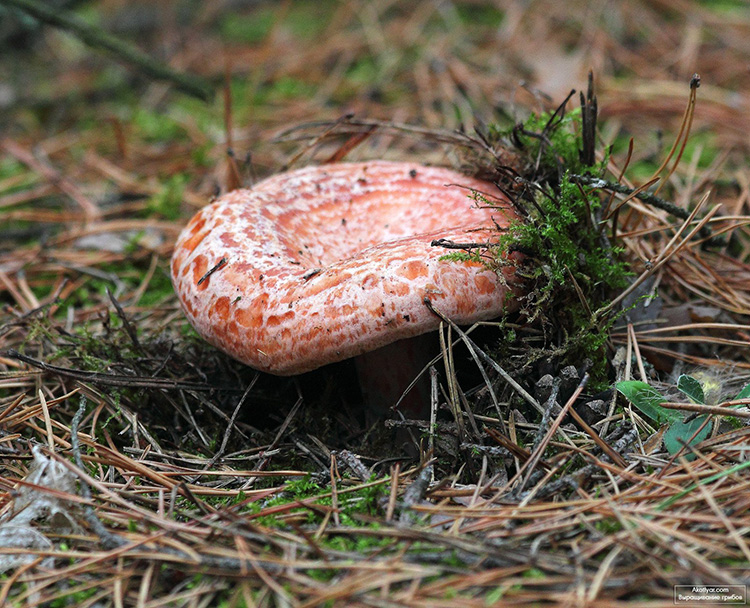
Not the most popular type of saffron milk cap. It is found in almost impenetrable coniferous forests. It differs in that it does not have mucus or milky juice familiar to other types of fungus. It is almost dry. The leg is also different, it seems to be covered with flour and has red blotches. Brittle enough.
False mushroom
Mushroom pickers insist - there are simply no false mushrooms! There are other types of mushrooms very similar to saffron milk caps, some of which are inedible and dangerous!
A real edible camelina mushroom at the break points exudes a pleasant smell of fresh resin.

However, if you look at them more closely, they have nothing to do with a real mushroom.
- Inedible lump. It is also called the amber milkman. The main difference from the saffron milk cap is the leg. It is usually long, incomplete and white in color. But we remember that a real saffron milk cap is usually the same color as the cap, and its leg is hollow.

Amber lactarius is an inedible mushroom, very similar to the mushroomTo confuse it with a mushroom is quite simple - their hats are similar, but the toadstool's leg has a characteristic skirt, which a real mushroom does not have.

The dangerous double of the saffron milk cap is the ubiquitous pale toadstool This group is the most harmless representative. The wave does not pose any threat. However, the difference is still worth knowing. The edges of the waves are more rounded, in addition, they are covered with a small fluff.

You can accurately check the mushroom for belonging to a noble family by cutting it off - if the cut site turns blue or dark green after a while, then this is a mushroom.

Pine mushroom
It grows only in pine forests. Usually attached to trees or grows close to the rhizome. Unlike other varieties of camelina, it often grows alone. A characteristic feature - they like to hide under branches or a thick layer of grass. Circles diverge in wider waves, they are often uneven, oval-shaped or even intermittent.

The upland mushroom loves to hide - it is better to look for it directly under the pine trees, in the grass
In the dry season there are more pine mushrooms, in the rainy summer there are more spruce ones.

Milky red mushroom

Due to its specific color, the saffron milk cap is quite noticeable. Inhabits coniferous forests, ripens in late autumn. Sometimes green is added to the orange-red colors. Otherwise, it has all the other properties characteristic of saffron milk caps.
Useful properties of camelina
In terms of the amount of individual vitamins, mushrooms are not inferior to vegetables and fruits. They are worthy of the honorary title - "multivitamin". Ryzhiks are rich in vitamins A and B1. Their use improves vision, condition of the skin, hair.
The real mushroom and the red mushroom close to it contains an antibiotic - lactarioviolin, which suppresses the development of many bacteria, including the causative agent of tuberculosis.
Mushrooms contain on average up to 90% water. The remaining 10% are distributed approximately as follows: up to 4% are proteins, up to 2% - fiber, up to 1.5% - carbohydrates, up to 1% - fats, up to 1.5% - minerals.
Mushroom proteins contain a large amount of amino acids, including essential ones, and are absorbed by the body by 70-80%. The nutritional value of mushrooms, like other foods, is largely determined by the total amino acid content. In terms of the content of the latter, mushroom proteins are comparable to animal proteins, which is why mushrooms are often compared to meat.
In terms of calories (per 100 g of product), mushrooms, being salty, surpass average beef by 78 calories, chicken - 75, salted herring - 54, chicken eggs - 43, whole milk by 17 calories. These "champions" are three times or more calories in calories in fruits, vegetables and some other products. None of the mushrooms can be compared with camelina in digestibility.
Ryzhiks do not contain any bitterness at all. By the way, some gourmets eat fresh mushrooms as well - in this case, you can feel the true taste of the mushroom. Gingerbread contains many useful substances, so you can eat them without any concern for your health.
Dangerous properties of camelina
There are few contraindications to the use of these mushrooms. So, in large quantities, they can cause constipation, muscle weakness and reduced working capacity. Also, mushrooms are not advised to include in the diet for cholecystitis, low acidity of gastric juice, pancreatitis and individual intolerance. In addition, this product is not recommended for those who have had their gallbladder removed.
Fresh mushrooms can only harm if they are confused with inedible mushrooms that look similar in appearance, which can lead to madness, poisoning or even death. Therefore, you can collect mushrooms on your own only if you are well versed in mushrooms.
Although fresh mushrooms are low in calories, pickled and salted they are extremely high in calories. Therefore, overweight people are not advised to consume mushrooms processed in this way.
Gray-pink Miller (Lactarius helvus)
Synonyms:
Gray-pink miller (lat.Lactarius helvus) is a mushroom of the genus Miller (lat.Lactarius) of the russula family (lat.Russulaceae). Conditionally edible.
Gray-pink milky's hat:
Large (8-15 cm in diameter), more or less rounded, equally prone to both the formation of a central tubercle and a depression; with age, these two signs can appear at the same time - a funnel with a neat bump in the middle. The edges in youth are neatly tucked up, gradually roll out as they mature. Color - hard to describe, dull grayish brownish pink; the surface is dry, velvety, not prone to hygrophilousness, does not contain any concentric rings. The pulp is thick, brittle, whitish, with a very strong spicy odor and a bitter, not particularly pungent taste. Milky sap is scanty, watery, in adult specimens it may be completely absent.
Plates:
Weakly descending, medium frequency, the same scale as the hat, but somewhat lighter.
Spore powder:
Yellowish.
Gray-pink lactarius leg:
Quite thick and short, 5-8 cm in height (in mosses, however, it can be much longer), 1-2 cm in thickness, smooth, gray-pinkish, lighter than the cap, in youth, solid, strong, forms uneven lacunae.
Spreading:
The gray-pink miller is found in bogs among birches and pines, in mosses, from early August to mid-October; in late August-early September, it can, under favorable circumstances, bear fruit in huge quantities.
Similar species:
The smell (spicy, not very pleasant, at least not for everyone - I don't like it) allows you to distinguish the gray-pink milky from other similar mushrooms with complete confidence. For those who are just starting to get acquainted with the milkmen, relying on literature, we will say that another relatively similar mushroom with a strong smelling pulp, the oak milkman Lactarius quietus grows in dry places under oak trees, is much smaller and, on the whole, is not at all similar.
Edibility:
In foreign literature, it is listed as weakly poisonous; here it is referred to as inedible or as edible, but of little value. People say that if you are willing to put up with the smell, then you get a milkman like a milkman. When it appears in the absence of valuable commercial mushrooms, it is at least interesting.
Remarks An enthusiast of mushroom pleasures is always uncomfortable to admit such things, but Lactarius helvus became one of the few milkmen who made a brightly inedible impression on me. A large, weighty mushroom with an unpleasantly dry cap, not affected by either a worm or a slug, for some reason does not fit into the basket. Perhaps it's a suspicious smell; if it were even a little weaker, it could be called piquant, spicy, or just like a chemical weapon. As with many other common mushrooms growing in pines, I met the gray-pink lactarius very late, at a conscious mushroom age; met and under the first pretext that came across, interrupted the acquaintance. Something is wrong here. Something the same as that of the oak milkman. It seems like a mushroom of a noble family and a valiant article, and not happy. Or the problem is no longer even in the mushroom ...
How to cook mushrooms:
Ryzhiks are one of the most nutritious mushrooms. They are rich in amino acids, vitamins and iron. In terms of calories (per 100 g of product), these mushrooms, being salty, surpass average beef by 78 calories, chicken meat by 75, salted herring by 54, chicken eggs by 43, and whole milk by 17 calories. These "champions" are three or more times more caloric than fruits and vegetables. It is believed that none of the mushrooms can be compared with camelina in digestibility.
The calorie content of fresh mushrooms, like other mushrooms, is low, and amounts to about 17 kcal per 100 g of mushrooms.
They are used fresh (frying, soups), for pickling and pickling, sometimes dried (and then they are often made into a powder, which serves as the basis for sauces and soups).
When fresh, they do not require pre-boiling. As for milk mushrooms, the main task when cooking mushrooms is to preserve taste and aroma as much as possible.
Salted mushrooms are very tasty. Before salting, you do not need to wash them: freshly picked mushrooms must be peeled and wiped clean, folded into a bucket with their caps up; Sprinkle each row with salt, cover, put oppression on it; when the mushrooms settle, add fresh ones. As with salting milk mushrooms, spices are not used when salting mushrooms.
Ready-made salted mushrooms are served with onions, garlic or black pepper. They are often added to salads. They go well with potatoes, onions and vegetables. Salted mushrooms are used to make homemade okroshka.
Hot salting is contraindicated for mushrooms, as with it the mushrooms lose their unique aroma. If you nevertheless decide to salt these mushrooms in a hot way, then you do not need to boil them, it is enough just to pour boiling water several times.
There is another rare method of pickling saffron milk caps - dry. Only the smallest mushrooms are salted with it. Only salt is put in mushrooms
They are not washed, but carefully wiped with a damp sponge and placed in a glass or enamel dish, covered with a rag, and a gauze bag with salt is placed on top (1 full glass of fine salt on a bucket of mushrooms), and then a wooden circle and oppression. After 1-1.5 months, mushrooms become unusually tasty and aromatic
With this treatment, the mushrooms completely retain their shape, bright color and aroma.
Camelina recipes
Knowledgeable mushroom pickers believe that real mushrooms should be eaten salted without spices, then they acquire an incomparable forest taste, give off needles, and a slight bitterness of pine resin. Therefore, the mushrooms are salted immediately after collection, wiping with a clean cloth, tightly packed in a container and generously sprinkled with salt. Such pickles are eaten in 10-14 days.
The need for quick harvesting of saffron milk caps is justified not only by their excellent taste, like other mushrooms, it is a perishable product that should be processed as soon as possible.
Salted mushrooms with spices
At home, you can cook delicious spicy mushrooms, which are obtained with cold salting. To do this, for 1 kg of mushrooms, take 40 g of salt, a little bay leaf and black currant leaves, allspice and black pepper to taste.
Mushrooms are poured with boiling water twice, before pouring them onto a sieve, after which they are doused with cold water, and left to dry a little.
Salt and spices are placed at the bottom of the container, mixing them and sprinkling them in a thin layer. Then the mushrooms are spread, with caps on top, in rows up to 7 cm thick, each layer is salted and pepper. All the remaining spices are placed on top. The workpiece is covered with a piece of cotton fabric, a wooden circle, pressed down with oppression and taken to the basement. It is convenient to use a glass bottle of water as oppression.
After a few days, brine appears and, if it is not there, the severity of the oppression increases. Excess brine is drained if necessary. Such spicy mushrooms can be eaten in a month, and the snack is stored in the refrigerator.
Marinated baked mushrooms
This delicious original appetizer will serve as an excellent decoration for a festive table. And in terms of juiciness and forest aroma, it cannot be compared with any purchased delicacies.
To prepare the marinade take:
- 1 liter of vinegar with a strength of 3.5%;
- 20 g sugar;
- 20 g salt;
- 5-7 bay leaves;
- some cloves.
All components are mixed and brought to a boil.
Put the peeled mushrooms washed under running water on a baking sheet and put in a hot oven for 10-12 minutes. Then they take it out of the oven, cool it a little, put it in jars while still warm and fill it with hot marinade.
After that, the jars are sealed with plastic lids and, as soon as they have cooled, they are placed in the refrigerator. For long-term storage, canned food is covered with metal lids, sterilized for 30–40 minutes, and then sealed.
Gingerbreads in sour cream
The classic mushroom dish turns out to be especially tasty when using saffron milk caps.To prepare, perform the following steps:
- Finely chop the onions and fry until golden brown.
- Mushrooms are peeled, washed, large ones are cut into halves, lightly sprinkled with flour and fried.
- Combine mushrooms with onions, add sour cream and heat until boiling.
The dish is salted, ground pepper, finely chopped dill and other spices are added to taste.
How to grow mushrooms mushrooms (with video)
These mushrooms can only be grown in natural conditions. For them, you need to choose a place that, in terms of its conditions, does not differ from the place of natural growth of mushrooms. Consideration should be given to lighting, moisture, soil condition, species and age of trees. It is better to choose shaded, but not dark places with free air movement for saffron milk caps. The soil should be moist and slightly acidic, contain a lot of rotting leaves and needles. But at the same time, in the spring, it should not be flooded with water. It can be specially planted for these purposes on a plot of pine or spruce.
Ryzhiks can be eaten fried, salted, pickled. When salted, they are not soaked, not boiled, but simply washed and wiped. In ancient times, they were salted in a special oak dish without any spices, so as not to interrupt the natural smell and taste of mushrooms.
Gingerbreads can be sown in the same way as porcini mushrooms, in several ways. Collect the caps of old overripe mushrooms in the forest and chop them into pieces. Dry a little on a thin cloth (gauze is suitable for this purpose), periodically turning it over on the other side. In the selected area, raise the top layer of soil and place pieces of the cap under it. Seal well and pour over with warm water. Or spread the pieces of the cap on loose soil and also pour water over it.
Or soak old caps in rainwater with added sugar. The next day, mix well and pour under the selected trees.
You can transplant the found mycelium. For this, it should be carefully, without damage, dug in the forest in the form of layers measuring 30 x 30 cm and 25 cm thick and brought home. Moreover, it is necessary to ensure that the earth does not shake, otherwise the mycelium will be damaged. Layers of earth, without waiting for them to dry, must be immediately planted under the same trees under which they were dug
To do this, in advance, dig holes of the required size and carefully transfer layers of earth into them. Then sprinkle with rainwater
It is better to transplant myceliums in the morning or in the evening.
You can also lay out the old hats in the selected area and cover with moss. In dry weather they should be watered with water. After 2 weeks, the moss will rise and underneath it will be possible to see the greenish-purple filaments of mycelium.
Cultivation of saffron milk caps consists of watering in dry weather. It should be watered with either rain or well water. The first mushrooms will appear only the next year after the mycelium is planted.
When collecting mushrooms, you must carefully cut off with a knife, otherwise you can damage the mycelium
In the next section of the article, photos and descriptions of camelina mushrooms of different types are presented.
Watch the video "Growing Camelina Mushrooms", which shows all the subtleties of care:
The edibility of this mushroom
Real mushrooms are great for pickling and pickling, but they are not suitable for drying. The taste of this saffron milk cap is spicy, pleasant, and the aroma is fruity.
In terms of taste, this edible mushroom belongs to the 1st taste category, that is, it is very tasty. The chemical composition of this mushroom includes fats, proteins, carbohydrates, in addition, there is a biological substance fungin, which stimulates gastric secretion. In addition, mushrooms are low in calories.

Real mushroom has a slightly bitter taste. After cooking, the mushrooms take on a slightly greenish tint. This mushroom differs from its counterparts in a denser leg, which is good for salting. When salted and pickled, the red color of the mushroom is preserved. But mushrooms are not suitable for drying. They are often stewed with onions and paprika.
Similar species
With a real mushroom, you can confuse a volyanka, a pink volushka and a milk lover.Pink wolves differ from saffron milk caps in the color of the plates and juice; in the wavelets they are colorless, while in the saffron milk caps they are orange.
It is safe to collect mushrooms, since there are no false and poisonous similar species.
The disadvantage of camelina is that it becomes infected with fungal worms more often than other mushrooms, especially when the weather is humid.

Salted mushrooms. How to salt mushrooms?
Usually mushrooms are salted dry, cold and hot.
Only mushrooms are salted dry. This kind of blank is preferable for them. Previously, the mushrooms are cleaned of dirt, wiped with a clean, preferably a linen cloth and placed in layers in a container with plates facing up. Mushrooms must not be salted in galvanized, copper, tin and plastic containers, since the interaction of brine with such materials produces poisonous compounds. Each layer is sprinkled with coarse salt. Spices are not put in mushrooms so as not to kill their own aroma and taste. After half of the mushrooms have been laid, they are kept for 5 hours. When they settle, add the other half to them. Cover with a cloth on top and put a wooden circle, which is pressed down with oppression. They are kept at room temperature for two to three days to begin the fermentation process. Then they are placed in cellars and kept at 5 ° C. Salted mushrooms can be eaten in a day, but they acquire a richer taste after 10-15 days. After this period, they are transferred to clean containers.
The cold method of salting saffron milk caps differs from the dry method only in that the mushrooms are washed several times before being placed in a container.
For the hot method of salting, mushrooms are first scalded 2 times with boiling water, then cooled with cold water and dried. To make the mushrooms spicy, they can be shifted with ground black pepper, currant leaves and laurel. But this will already be the taste of seasonings, not saffron milk caps.

Photo by: Josep Xicota, CC BY-SA 3.0
Distribution locations and collection times
Ryzhiks of all types prefer coniferous forests, but they can also grow in mixed plantings under pine or spruce trees. Favorite places - edges, forest glades, felling sites, young spruce and pine forests. Most often, these mushrooms are found in the northern regions, the forests of the Urals and Siberia.
It can be difficult to find mushrooms - they hide in groups under fallen soft needles, in dry weather they are almost nonexistent, and after drizzling summer and autumn rains they suddenly appear en masse, raising their shelters from needles and grass, highlighting with a warm orange color to match the color of pine bark.
Filming begins in July, the main harvest falls in August and lasts until September. Experienced mushroom pickers notice the growing areas of orange mushrooms and, after each rain, again and again collect fragrant forest harvests.
Volnushka and camelina contrast. What do we know about saffron milk caps. Interesting facts about these wonderful mushrooms.
Ryzhiki ... How this simple word makes the heart of a mushroom picker beat faster ... Ryzhiki ... Some of the best mushrooms in Russian forests. Ryzhiki ...
Baskets full of good health and excellent mushrooms!
Mushrooms ... Many mushroom pickers put them on a par with porcini mushrooms. If there are those who do not quite agree with this statement, then few will argue that these are the best of the lamellar mushrooms. Well. only if fans of milk mushrooms or honey agarics grin displeasedly at the first place of the mushroom.
PINE GREEN
- There are 2 varieties of camelina: pine and spruce. The first is larger, fleshy, solid. And even more "red" (or so it seems to me?) In comparison with his spruce brother. Otherwise, they are almost twins.
- Although some mushroom pickers believe that the upland mushroom is a little bit more bitter, and its fate is only salting. But they are harvested more readily than their spruce counterparts. Their flesh is denser, in a salted form they are less fragile and retain a bright color.
- Spruce mushroom is smaller and more tender than pine. It is very good when fried fresh in a skillet. If they are salted, the spruce mushrooms acquire a dark green color.
Spruce mushroom
- But few people fry them, although they are very tasty when fried! These mushrooms (both types) have long been considered a delicacy. At the same time, it's not just about taste. The mushrooms are very nutritious. They surpass chicken eggs and beef in calories.
- Ryzhiks are distinguished by an alliance with conifers, a reddish-green color of the cap and pulp, red or red milky juice, which either turns green in the air, or, on the contrary, turns red densely.
PINE GREEN
The flesh of these mushrooms is brittle, secreting a tart, carrot-red milky juice, with a spicy, resinous (some mushroom pickers claim to be fruity) odor. Their taste is slightly spicy.
- And this is despite the fact that mushrooms, like milk mushrooms or volushki, belong to the lactarius family. But, unlike the overwhelming majority of milkmen, their juice is not pungent, but slightly sweet and slightly spicy.
- Typical periods of massive growth are from late June to mid-August. The second wave is from late August to mid-September. Very often these mushrooms grow in large groups (colonies).
- In terms of assimilation by the human body, mushrooms are far ahead of all other edible mushrooms. If you want to preserve a special resinous aroma, they are not soaked or boiled, unlike other milky mushrooms.
Spruce mushroom
- Among experienced mushroom pickers, the method of quick salting is popular. Salted, waited for the release of juice, and ... crispy mushrooms can be eaten (or rather, they can already have a snack !!!).
- Before the 1917 revolution in Russia, salted mushrooms were divided into two varieties. The first included the Kargopol "red" (pine forest), the second - the Tver "bruises" (spruce).
- Salted mushrooms were in great demand more than a century ago, not only in Russia, but also abroad. For example, small fungi were sent to France in special bottles, which were valued more expensive in Paris than champagne.
PINE GREEN
- If you want to preserve a special resinous aroma, the mushrooms are not soaked beforehand or, God forbid, they are not boiled, unlike other milky mushrooms. Experienced mushroom pickers salt them only dry, without any herbs, plant leaves, garlic, etc.
- Ryzhiks are distinguished by the highest, among other edible species of mushrooms, the content of vitamin A. They contain 16 amino acids, including those indispensable for the human body.
Ryzhiks are very popular with mushroom pickers in all countries where they grow. They are very noticeable, fragrant and unforgettable in their taste!
Camelina mushrooms: benefits and harms for humans
Camelina mushroom, provided that it is collected in an ecologically clean place, can help you slightly improve your body. Hard, not dry mushrooms contain a huge amount of vitamins and minerals. Therefore, if you use mushrooms very often, then you will help your body to work properly.
Useful properties of camelina mushrooms:
- Toning. Ascorbic acid, which is in the composition of mushrooms, will help you always stay alert and easily endure physical activity.
- Strengthening. The presence of phosphorus, potassium and calcium will help keep your nails, hair and teeth in perfect condition.
- Antibacterial. The substance lactrioviolin, which is a natural antibiotic, has similar properties. That is why, in folk medicine, mushrooms are very often used for the preparation of anti-tuberculosis drugs.
- Fat burning. Of course, mushrooms do not directly affect fat cells. But their regular use increases metabolism, and against this background, the body fat decreases significantly.
As for the harm of saffron milk caps to the human body, they have only one small minus. They contain a substance that can irritate the mucous membranes of the gastrointestinal tract. Therefore, if a person suffers from pancreatitis, colitis, gastritis or peptic ulcer, then it is better for him not to eat these mushrooms.
This mushroom can be called one of the most valuable sources of all kinds of useful substances.It contains an increased concentration of vitamins important for health and metabolism (thiamine, riboflavin, ascorbic acid), as well as trace elements such as ferum, calcium, phosphorus and potassium.
As you know, the bright orange tint of camelina is a consequence of the increased carotene content. This substance belongs to natural antioxidants, therefore, regular consumption of the mushroom makes it possible to increase immunity, protect against atherosclerosis, and also increase the overall barrier function of the body.
Has mushroom and antibiotic properties. Due to the presence of lactarioviolin, its inclusion in the diet contributes to the suppression of a whole complex of all kinds of pathogenic microorganisms. This promotes the natural treatment of foodborne infections and even provides an opportunity to fight tuberculosis. Do not forget about the high nutritional value of camelina. It contains a record amount of easily digestible protein, the biological value and nutritional value of which is not inferior to meat.
Did you know? Mushrooms appeared on the planet about 400 million years ago (earlier than dinosaurs) and are considered one of the oldest forms of life.


